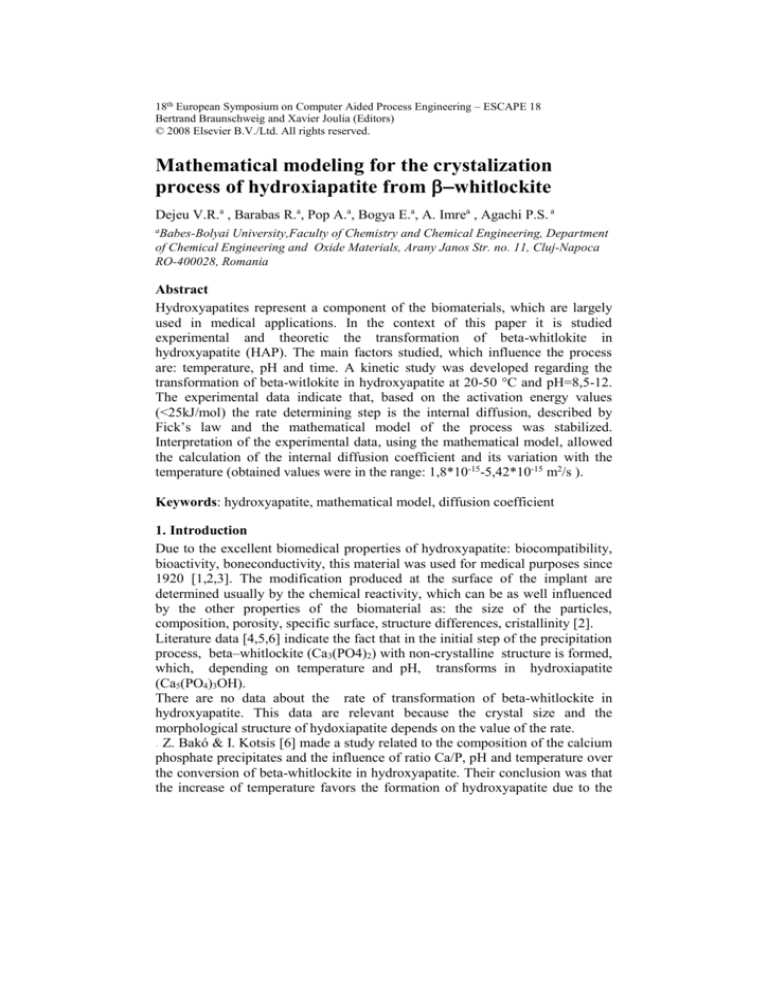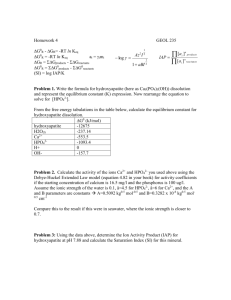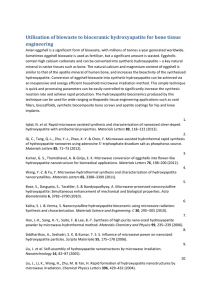
18th European Symposium on Computer Aided Process Engineering – ESCAPE 18
Bertrand Braunschweig and Xavier Joulia (Editors)
© 2008 Elsevier B.V./Ltd. All rights reserved.
Mathematical modeling for the crystalization
process of hydroxiapatite from whitlockite
Dejeu V.R.a , Barabas R.a, Pop A.a, Bogya E.a, A. Imrea , Agachi P.S. a
a
Babes-Bolyai University,Faculty of Chemistry and Chemical Engineering, Department
of Chemical Engineering and Oxide Materials, Arany Janos Str. no. 11, Cluj-Napoca
RO-400028, Romania
Abstract
Hydroxyapatites represent a component of the biomaterials, which are largely
used in medical applications. In the context of this paper it is studied
experimental and theoretic the transformation of beta-whitlokite in
hydroxyapatite (HAP). The main factors studied, which influence the process
are: temperature, pH and time. A kinetic study was developed regarding the
transformation of beta-witlokite in hydroxyapatite at 20-50 °C and pH=8,5-12.
The experimental data indicate that, based on the activation energy values
(<25kJ/mol) the rate determining step is the internal diffusion, described by
Fick’s law and the mathematical model of the process was stabilized.
Interpretation of the experimental data, using the mathematical model, allowed
the calculation of the internal diffusion coefficient and its variation with the
temperature (obtained values were in the range: 1,8*10-15-5,42*10-15 m2/s ).
Keywords: hydroxyapatite, mathematical model, diffusion coefficient
1. Introduction
Due to the excellent biomedical properties of hydroxyapatite: biocompatibility,
bioactivity, boneconductivity, this material was used for medical purposes since
1920 [1,2,3]. The modification produced at the surface of the implant are
determined usually by the chemical reactivity, which can be as well influenced
by the other properties of the biomaterial as: the size of the particles,
composition, porosity, specific surface, structure differences, cristallinity [2].
Literature data [4,5,6] indicate the fact that in the initial step of the precipitation
process, beta–whitlockite (Ca3(PO4)2) with non-crystalline structure is formed,
which, depending on temperature and pH, transforms in hydroxiapatite
(Ca5(PO4)3OH).
There are no data about the rate of transformation of beta-whitlockite in
hydroxyapatite. This data are relevant because the crystal size and the
morphological structure of hydoxiapatite depends on the value of the rate.
. Z. Bakó & I. Kotsis [6] made a study related to the composition of the calcium
phosphate precipitates and the influence of ratio Ca/P, pH and temperature over
the conversion of beta-whitlockite in hydroxyapatite. Their conclusion was that
the increase of temperature favors the formation of hydroxyapatite due to the
2
V.Dejeu et al.
intensification of the diffusion processes, without to show how the studied
factors influence the diffusion process.
The proposed objective of this paper was the study of the kinetic process
regarding the transformation of beta-whitlockite in hydroxyapatite and to
establish the factors, which influence this process and its mathematical model.
2. Experimental procedure
For the preparation of hydroxyapatite it was described in the paper of Z. Bakó
& I. Kotsis [6]. The temperature in the vessel was 200C and 500C and pH=8,7;
9,1; 10,2; 11,3; 12. From time to time samples were taken, the precipitate was
filtered, thoroughly washed with bi-distilled water until the NO3- and NH4+ were
eliminated and dried at 105 0C for 2 hours. The samples were investigated on a
DRON-3 Diffractometer with Cu Kα radiation in the range 15-16 2θ.
3. Results and discussion
The formation of hydroxyapatite by precipitation is a complex process, which
includes the following elementary steps:
1. the reaction of Ca(NO3)*4H2O and (NH4)2HPO4, resulting beta–
whitlockite
2. the dissolution of beta–whitlockite
3. the formation of hydroxyapatite germs
4. the diffusion of the Ca2+ and PO43- ions in the liquid phase and pores
To establish the rate determining step, there were made experimental
measurements to study the influence of temperature and pH of precipitation
over the formation speed of hidroxyapatite. The evolution in time of the process
was traced through the conversion of beta-whitlockite in hydroxyapatite. The
influence of pH and temperature over the global rate of the process is plotted in
Fig. 1. This figure show that both temperature and pH have a great influence on
the formation of the precipitate. At pH=8.5 the conversion of beta-whitlockite in
hydroxyapatite reached 49% wt at 20 0C (Fig. 1-b) and 87%wt at 50 0C (Fig. 1a). For values of pH higher than 8.5, the conversion reaches values of even
100%wt after less than 2-4 hours.
1
1
0.9
0.9
0.8
0.8
0.7
0.7
0.5
0.6
0.4
0.5
pH =
pH =
pH =
pH =
pH =
pH =
0.3
0.2
0.1
0
0.6
0
1
2
3
4
5
time, [s]
a
6
7
8.5
9.1
9.7
10.2
11.3
12.0
pH =
pH =
pH =
pH =
pH =
pH =
0.4
0.3
8
9
4
x 10
0.2
0
1
2
3
4
5
time, [s]
b
6
7
8.5
9.1
9.7
10.2
11.3
12.0
8
9
4
x 10
Figure 1. Conversion of beta-whitlockite in HAP at 20 0C (a) and 50 0C (b)
Applications of mathematical modelling in the technology of biomaterials
3
In Fig. 2 is plotted the influence of pH and temperature versus the conversion of
beta-whitlockite in HAP at different moments of process evolution. A
continuous increase of the conversion versus pH along the development of the
process can be observed at 2000÷16000 s with the remark that at 50 0C the
influence of the pH is more significant (Fig. 2-b). The =f (time) curve at 20 0C
(Fig. 2-a) remains parallel, which indicates the great influence of pH over the
conversion. Considering that the transformation of beta-whitlockite in HAP
follows a first order kinetics, –ln(1-η)=f (time) was plotted. From the slope of
the plot the values of the rate constants listed in Table1 were determined.
X. Zhu [7] sustains that the rate of cristallinity is determined by the value of the
activation energy of the atoms, without indicating the values. He affirms that the
quantity relation between the rate of the process and temperatures can be
expressed by a relation of Arrhenius type: k k 0 exp( Ea / RT ) , where k is
the rate coefficient, A is a constant, Ea is the activation energy, R is the
universal gas constant, and T is the temperature (in degrees Kelvin).
Starting from this hypothesis, the dependence –ln k=f (1/T) was plotted; from
the slope of the curve the energy of activation was calculated; the values are
shown in Table 1. It was found that the activation energy has in all cases values
in the range: 3,43-4,75 kcal/mol, which indicates that the limiting process is the
diffusion.
1
0.9
0.9
0.8
0.8
0.7
0.7
1
0.6
0.6
0.5
0.5
0.4
t
t
t
t
0.3
0.2
8.5
9
9.5
10
10.5
11
=
=
=
=
0.4
9600 s
11700 s
13900 s
16000 s
11.5
t
t
t
t
0.3
12
0.2
8.5
9
pH
a
9.5
10
10.5
11
=
=
=
=
9600 s
11700 s
13900 s
16000 s
11.5
12
pH
b
Figure 2. The influence of pH and temperature over the global rate of the
process at 20 0C (a) and at 50 0C (b)
Table 1. The values of the rate constants and the activation energy
pH
9,1
9,7
10,2
11,3
12
ln k1
20 0C
-9,33
-9,21
-9,18
-9,15
-9,13
ln k2
50 0C
-8,78
-8,51
-8,47
-8,42
-8,37
Ea [kcal/mol]
3,43
4,37
4,43
4,56
4,75
4
V.Dejeu et al.
Intense mixing of the stirrer (intense hydrodynamic conditions from liquid
phase) and the small dimensions of the channels from the inside of the crystals
suggested us that limitative step is the internal diffusion through the pores.
The kinetic equation, which stays at the base of the mathematical description of
the trasformation process of beta-whitlockite in hydroxiapatite is given by the
Fick’s law:
dnHAP
dC HAP
D0
Sd
dr
(1)
where D is the diffusion coefficient, CHAP is the concentration, nHAP is the
number of mols and surface S=4r2, where r is the radius of the hydroxiapatite
crystal at one moment .
The integration of the equation (1) gives:
dn HAP 1 1
4D0 C HAP
d r R
(2)
where dnHAP * 4 r 2 dr , *
V X
M
(where is the density, X is the
weight ratio, M is the molecular weight, V is the volume of the hydroxiapatite
particle. The relation between the transformation rate, the radius at one moment
r and final radius R is given by the relation:
R3 r 3
, which leads to:
R3
d
D0
1
1
3
C HAP
1/ 3
R2
1
d
(3)
Taking into consideration that the solubility of HAP (CHAP) is constant the
integration of equation (3) gives:
1 R2
[1 3(1 ) 2 / 3 2(1 )]
6 D0 C HAP
(4)
Table 2. The values of the diffusion coefficient
pH
8,5
9,1
9,7
10,3
11
12
D01 [m2/s] ·1015
20 0C
1,90
1,87
1,85
1,84
1,81
1,80
D02 [m2/s] ·1015
50 0C
5,42
5,36
5,23
5,21
5,16
5,12
Applications of mathematical modelling in the technology of biomaterials
Fitting the experimental data by the integration method -F(where
F( 1 3(1 ) 2 / 3 2(1 )
allows the deduction of the diffusion
1 *R2
coefficients from the slope tg
(Table 2). Their analysis shows
D0 C HAP
that the diffusion coefficients are influenced by temperature and the values
obtained fit to the literature data (10-12-10-15 m2/s) [8,9].
4. Conclusions
1. The influence of the temperature and pH on the transformation rate of the
beta-whitlockite in hydroxyapatite was investigated
2. From experimental data the k constant and the activation energy of the
process were calculated
3. The obtained small values of the activation energy (Ea<6 kcal/mol)
shows that the rate determining step is the diffusion.
4. The mathematical model of the transformation of beta –whitlockite in
hydroxyapatite and the diffusion coefficients was established
The determination of the numerical values for the diffusion coefficient D0 will
allow, using the proposed model, to solve the simulation and optimization
problems of the process.
References
1. Xiaolong Zhu, Nano Hydroxiapatite/Collagen, Nano Hydroxiapatite and
Anodic Oxides on Titamun, 2005
2. Z. Bako, I. Kotsis, Composition of precipitated Calcium Phosphate Ceramics,
Ceramics International, 18, 1992, 373-378
3. M. Vallet-Regi, Ceramics for Medical Applications, J. Chem. Soc., Dalton
Trans.,2001, 97-108
4. S. Zhang, K. E. Gonsalves, Preparation and Characterization of Thermaly
Stable Nanohydroxiapatite, Journal of Materials Sciece: Materials in
Medicine, 8, 1997, 25-28
5. E. C. Moreno, T. M. Gregory, W. E. Brown, Preparation and Solubility of
Hydroxiapatite, Journal Research of the National Bureau of Standards-A.
Phsysics and Chemistry, 72A, 6, November-December 1968
6. L. C. Chow, L. Sun, B. Hockey, Properties of Nanostructural Hydroxiapatite
Prepared by a Spray Drying Technique, 109, 6, November-December 2004
7. C. S. Chai, B. Ben-Nissan, Bioactive Nanocrystaline sol-gel Hydroxiapatite
Coatings, Journal of Materials Science: Materials in Medicine, 10, 1999,
465-469
8. K. M. Allal, M. Abbessi, A. Mansour, a., Trans. Chem. E., 70, part. B, 1992,
p.140
9. G. Mura, A. Lallai, P. Olla, Chem. Eng. J., 1, 1991
5












